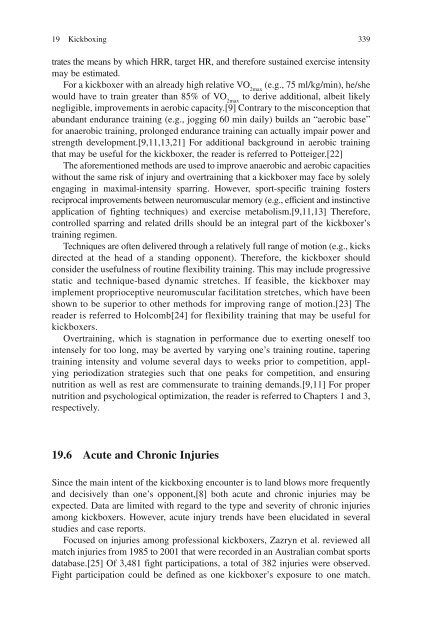Nutrition in Combat Sports
Nutrition in Combat Sports
Nutrition in Combat Sports
You also want an ePaper? Increase the reach of your titles
YUMPU automatically turns print PDFs into web optimized ePapers that Google loves.
19 Kickbox<strong>in</strong>g 339<br />
trates the means by which HRR, target HR, and therefore susta<strong>in</strong>ed exercise <strong>in</strong>tensity<br />
may be estimated.<br />
For a kickboxer with an already high relative VO (e.g., 75 ml/kg/m<strong>in</strong>), he/she<br />
2max<br />
would have to tra<strong>in</strong> greater than 85% of VO to derive additional, albeit likely<br />
2max<br />
negligible, improvements <strong>in</strong> aerobic capacity. [9] Contrary to the misconception that<br />
abundant endurance tra<strong>in</strong><strong>in</strong>g (e.g., jogg<strong>in</strong>g 60 m<strong>in</strong> daily) builds an “aerobic base”<br />
for anaerobic tra<strong>in</strong><strong>in</strong>g, prolonged endurance tra<strong>in</strong><strong>in</strong>g can actually impair power and<br />
strength development. [9, 11, 13, 21] For additional background <strong>in</strong> aerobic tra<strong>in</strong><strong>in</strong>g<br />
that may be useful for the kickboxer, the reader is referred to Potteiger. [22]<br />
The aforementioned methods are used to improve anaerobic and aerobic capacities<br />
without the same risk of <strong>in</strong>jury and overtra<strong>in</strong><strong>in</strong>g that a kickboxer may face by solely<br />
engag<strong>in</strong>g <strong>in</strong> maximal-<strong>in</strong>tensity sparr<strong>in</strong>g. However, sport-specific tra<strong>in</strong><strong>in</strong>g fosters<br />
reciprocal improvements between neuromuscular memory (e.g., efficient and <strong>in</strong>st<strong>in</strong>ctive<br />
application of fight<strong>in</strong>g techniques) and exercise metabolism.[ 9, 11, 13] Therefore,<br />
controlled sparr<strong>in</strong>g and related drills should be an <strong>in</strong>tegral part of the kickboxer’s<br />
tra<strong>in</strong><strong>in</strong>g regimen.<br />
Techniques are often delivered through a relatively full range of motion (e.g., kicks<br />
directed at the head of a stand<strong>in</strong>g opponent). Therefore, the kickboxer should<br />
consider the usefulness of rout<strong>in</strong>e flexibility tra<strong>in</strong><strong>in</strong>g. This may <strong>in</strong>clude progressive<br />
static and technique-based dynamic stretches. If feasible, the kickboxer may<br />
implement proprioceptive neuromuscular facilitation stretches, which have been<br />
shown to be superior to other methods for improv<strong>in</strong>g range of motion. [23] The<br />
reader is referred to Holcomb [24] for flexibility tra<strong>in</strong><strong>in</strong>g that may be useful for<br />
kickboxers.<br />
Overtra<strong>in</strong><strong>in</strong>g, which is stagnation <strong>in</strong> performance due to exert<strong>in</strong>g oneself too<br />
<strong>in</strong>tensely for too long, may be averted by vary<strong>in</strong>g one’s tra<strong>in</strong><strong>in</strong>g rout<strong>in</strong>e, taper<strong>in</strong>g<br />
tra<strong>in</strong><strong>in</strong>g <strong>in</strong>tensity and volume several days to weeks prior to competition, apply<strong>in</strong>g<br />
periodization strategies such that one peaks for competition, and ensur<strong>in</strong>g<br />
nutrition as well as rest are commensurate to tra<strong>in</strong><strong>in</strong>g demands. [9, 11] For proper<br />
nutrition and psychological optimization, the reader is referred to Chapters 1 and 3,<br />
respectively.<br />
19.6 Acute and Chronic Injuries<br />
S<strong>in</strong>ce the ma<strong>in</strong> <strong>in</strong>tent of the kickbox<strong>in</strong>g encounter is to land blows more frequently<br />
and decisively than one’s opponent, [8] both acute and chronic <strong>in</strong>juries may be<br />
expected. Data are limited with regard to the type and severity of chronic <strong>in</strong>juries<br />
among kickboxers. However, acute <strong>in</strong>jury trends have been elucidated <strong>in</strong> several<br />
studies and case reports.<br />
Focused on <strong>in</strong>juries among professional kickboxers, Zazryn et al. reviewed all<br />
match <strong>in</strong>juries from 1985 to 2001 that were recorded <strong>in</strong> an Australian combat sports<br />
database. [25] Of 3,481 fight participations, a total of 382 <strong>in</strong>juries were observed.<br />
Fight participation could be def<strong>in</strong>ed as one kickboxer’s exposure to one match.

















